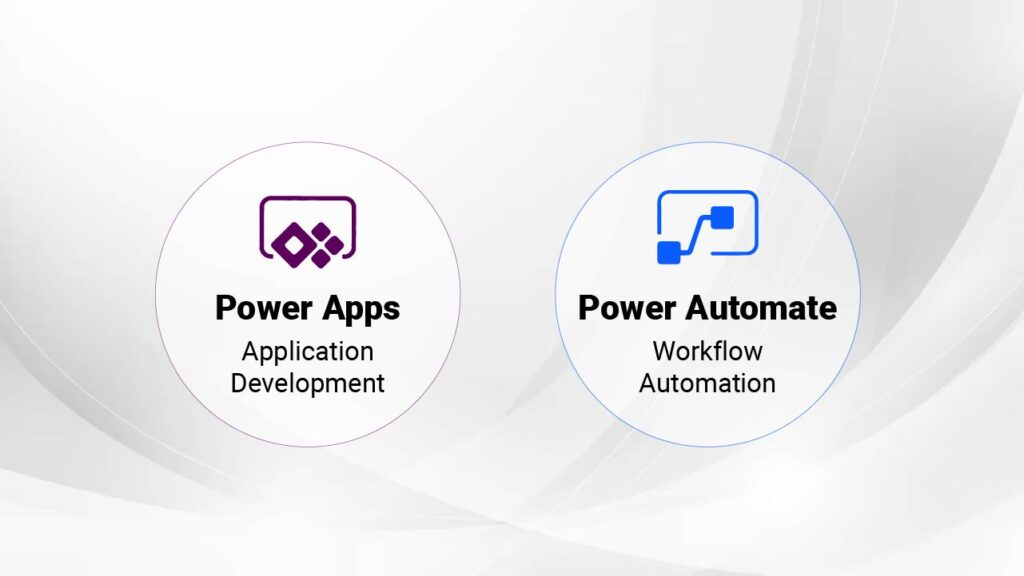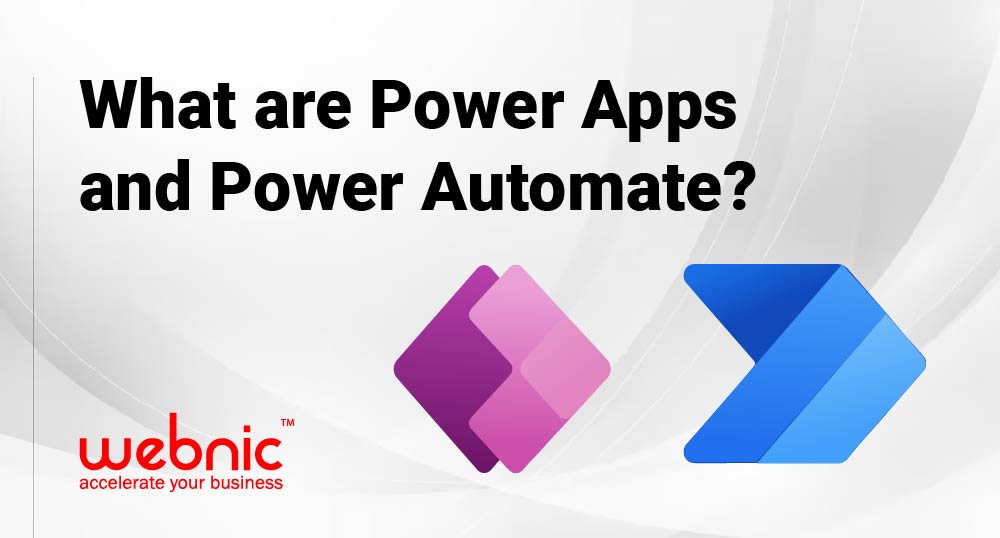Use PowerApps or Power Automate to its best potential, depending on your specific circumstances. Microsoft PowerApps is a powerful platform for creating custom applications, and it can benefit small businesses with few final consumers.
Introduction
You’ve undoubtedly heard about PowerApps and Power Automate if you’re familiar with the Microsoft Office 365 ecosystem. There is a lot of duplication between Microsoft’s PowerApps and Power Automate.
Before choosing one over the other, though, you should be aware of key differences. So, what exactly is the distinction between these two goods? Which one, specifically, would you choose for your company?
Here, we’ll look at the similarities and differences between PowerApps and Power Automate to help you choose the best solution for your company’s needs.
What is Microsoft PowerApps?
PowerApps is a low-code platform that lets companies create mobile applications for their staff. Using PowerApps, you may create an app from scratch or modify one of the available templates. The PowerApps platform allows for accessibility from any device with a web browser. Apps built using PowerApps can communicate with Microsoft’s other services through SharePoint and Dynamics 365 integrations. PowerApps is ideal for companies that require employee applications but need more personnel or budget to create them in-house.
What is Microsoft Power Automate work?
Power Automate is a program that helps companies streamline mundane procedures. Workflows using many programs, like email and SharePoint, are possible with Power Automate. You can additionally utilise Power Automate to schedule repeating actions in a single program, such as opening a specific file every day in Excel to generate a report. Power Automate is the way to go if your company needs to automate mundane processes.
Which platform should you use?
The correct response is conditional on the specifics of your company. PowerApps is the best platform to build distinct applications for your staff. Power Automate is the ideal system for anyone looking to streamline mundane processes.
PowerApps vs PowerAutomate
Before determining which solution is best for your company, you should know the differences between PowerApps and Power Automate. Let’s compare PowerApps to Power Automate and see what sets them apart.
The process of making changes and updates is where PowerApps and Power Automate diverge significantly. The PowerApps platform serves as the primary editing environment for all PowerApps. Your app will automatically update according to any changes you make to it. Power Automate employs a third-party app named Flow to change and enhance processes. Flow is a visual designer that lets you build your strategy by dragging and dropping operations. Because of this disparity, modifying PowerApps apps is much quicker and easier than changing Power Automate routines. PowerApps is the superior platform if frequent updates are required for your program.
PowerApps vs. PowerAutomate in Terms of Flexibility and Convenience
PowerApps is more flexible and versatile than Power Automate, which is a significant difference. In comparison to Power Automate processes, PowerApps apps offer greater flexibility. This is due to the accessibility of PowerApps across multiple platforms. On the other side, Power Automate processes are desktop PC-only. PowerApps is the superior platform for your app to work on mobile devices and web browsers.
Data entry forms built with PowerApps are only one example. However, you can’t make your forms with Power Automate processes. Compared to other Microsoft applications, PowerApps is also more adaptable regarding integration. Integration with SharePoint, Dynamics 365, and Power BI is possible using PowerApps. SharePoint is the sole supported platform for Power Automate workflow integration. PowerApps is the best option for a platform with more flexibility and customisation options.
Comparison and Improvement of PowerApps vs. PowerAutomate
One of the most distinguishing features of PowerApps and Power Automate is the procedure for making modifications and improvements. It is possible to change a PowerApps app without leaving the PowerApps environment. If you add changes to your application, it will automatically reflect those changes.
On the other hand, Power Automate utilises an external program known as Flow to effect these modifications and improvements. With Flow’s visual interface, you can simply drag and drop additional operations onto an existing workflow. As a result of this difference, adjusting Power Apps is considerably simpler and faster than modifying Power Automate scripts. If you need to make frequent changes to your program, PowerApps is the better platform to use.
Comparing the Convenience as well as Adaptability of PowerApps and PowerAutomate
The primary distinction between PowerApps and Power Automate is the former’s greater adaptability and versatility. When compared to Power Automate processes, PowerApp applications are more adaptable. This is because every device with a web browser can use PowerApps, regardless of the device’s operating system. On the other hand, Power Automate exclusively supports desktop PCs in its workflows. If you want the application to run on mobile devices and web browsers, PowerApps is the best option.
Using PowerApps, for instance, you can create your custom data entry forms. On the other hand, Power Automate workflows do not allow for creating customised forms. PowerApps also works better with Microsoft’s other software. Some examples of compatible platforms for PowerApps integration are SharePoint, Dynamics 365, and Power BI. The Power Automate workflow integration only works with SharePoint. PowerApps is the perfect platform to utilise if you’re looking for something adaptable and versatile.
PowerApps and PowerAutomate, Enhancement and revision
PowerApps and Power Automate differ significantly in terms of their intended purpose. PowerApps are most effective when used in tandem with other Microsoft services. On the other hand, workflows created in Power Automate don’t require any other Microsoft programs to function. Power Automate is the best platform if you need something that doesn’t require any other Microsoft products to work.
Comparison between PowerApps and PowerAutomate Membership Packages
Membership options for PowerApps as well as Power Automate are distinct. The Office 365 suite includes PowerApps. The Azure cloud service is where you can find Power Automate. PowerApps is the best solution if you require a platform that integrates with the rest of Microsoft’s Office 365 services. Power Automate is the best Azure-integrated platform to meet your needs.
That settles the matter, then! Some of the significant differences between PowerApps and Power Automate include the following. You can now choose the best platform for your company’s needs, having learned the distinctions between the two.

Advantages of PowerApps and PowerAutomate
Now that you understand the fundamental differences between PowerApps and Power Automate, it’s time to examine the advantages of each. The advantages of PowerApps are as follows:
- PowerApps are simple and fast to modify.
- In comparison to Power Automate processes, PowerApps apps offer greater flexibility.
- The PowerApps platform allows for accessibility from any device with a web browser.
- The advantages of using Power Automate are as follows:
- Workflows created in Power Automate are standalone and compatible with no other Microsoft software.
- In addition to Power Automate, Azure has several other advantages.
Which Method Do You Find Most Useful in the Workplace?
Ultimately, it comes down to strategy when deciding between PowerApps and Power Automate. The ideal choice for your company will depend on its use case’s specifics and the interactions it anticipates having with its apps. Consider two famous use cases while deciding between these two approaches. The first option is to use them to build a new, more complex computer program from the ground up. Alternatively, you can use them to create a hybrid app, which is very innovative.
Consider a team of five persons who are interested in a web-based collaboration solution that supports real-time analysis. PowerApps allows you to create an application that does more than just show you the data you’re collecting; it also helps you make out of it through visualisations and graphs. To better manage your team’s data, provide real-time analytics and visualisations, and promote remote cooperation, consider using Power Automate to create a hybrid app. The decision between the two options becomes more nuanced for large organisations with thousands of consumers. The trick is figuring out whether these tools will give you the greatest return on investment in terms of improving your chances of success.
Conclusion
That settles the matter, then! Some of the significant differences between PowerApps and Power Automate include the following. Having learned the distinctions between the two, you can select the best platform for your company’s needs. If you’re unsure what to do, it’s best to talk to a PowerApps or Power Automate pro first.
Ensure the consultant you hire has experience with both PowerApps and Power Automate. Working with a professional can help you choose the best platform for your company.

Meravath Raju is a Digital Marketer and a passionate writer working with MindMajix, a top global online training provider. He also holds in-depth knowledge of IT and demanding technologies such as Business Intelligence, Salesforce, Cybersecurity, Software Testing, QA, Data Analytics, Project Management ERP tools, etc.

Meravath Raju is a Digital Marketer and a passionate writer working with MindMajix, a top global online training provider. He also holds in-depth knowledge of IT and demanding technologies such as Business Intelligence, Salesforce, Cybersecurity, Software Testing, QA, Data Analytics, Project Management ERP tools, etc.

